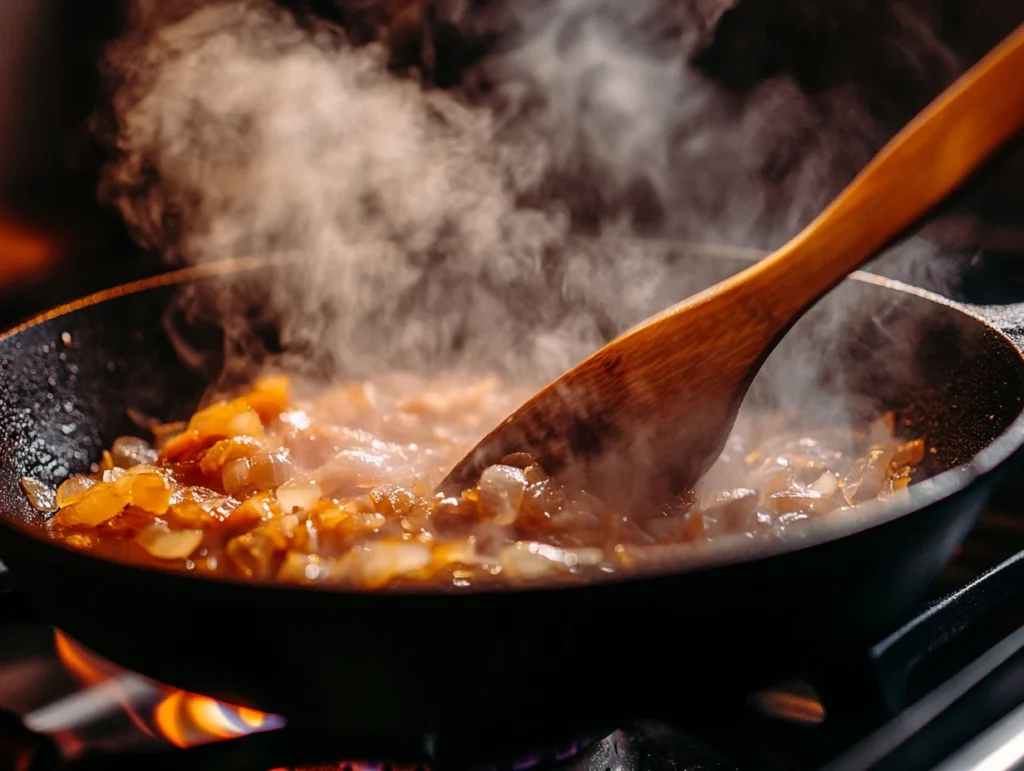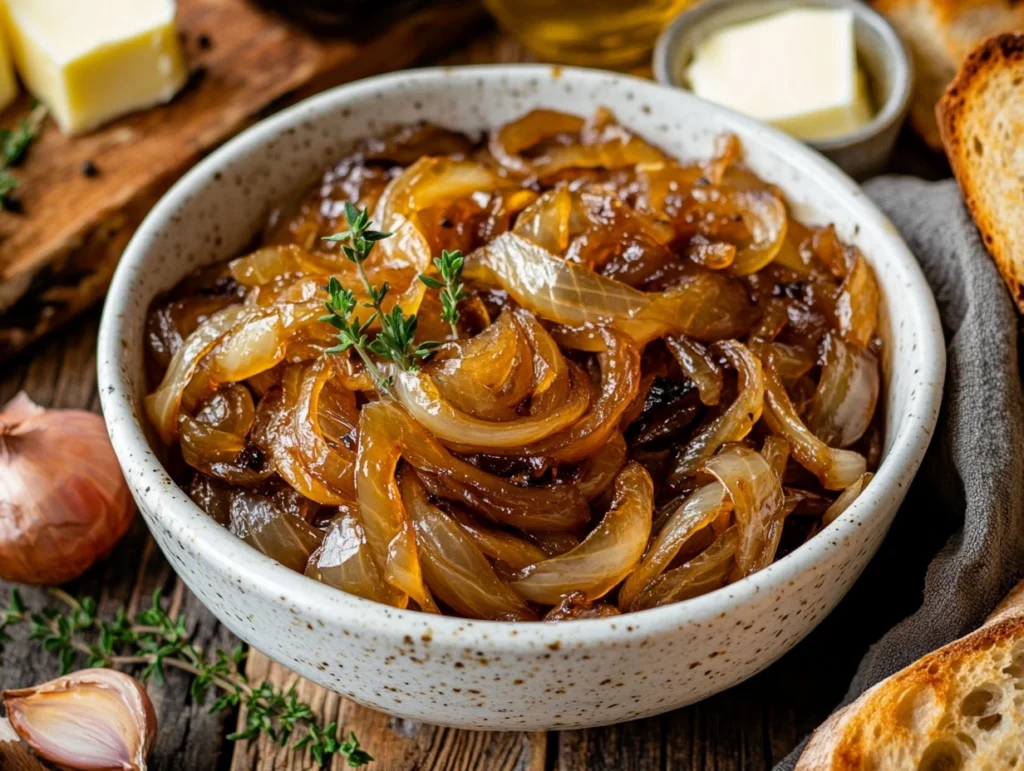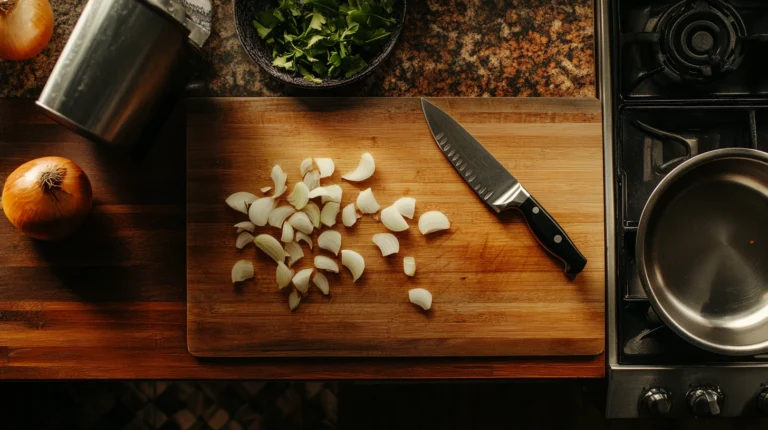Caramelized onions are a kitchen marvel. Their rich, golden-brown sweetness transforms ordinary dishes into extraordinary culinary experiences. But achieving that perfect texture and flavor requires patience and finesse. This article dives deep into the trick to caramelizing onions, exploring tools, techniques, and science-backed secrets to elevate your cooking skills. From slicing to serving, we’ve got you covered.
Introduction and Basics of Caramelizing Onions
What is Caramelization?
Caramelization is the slow cooking of natural sugars in foods, creating a deep, sweet flavor and beautiful brown color. When it comes to onions, this process breaks down their natural starches into sugars, turning sharp, pungent bulbs into soft, golden goodness. Understanding this process is the foundation for learning the techniques for caramelized onions.
Why Caramelize Onions?
Caramelized onions add depth and complexity to any dish, whether you’re topping a burger or stirring them into a soup. Their versatility makes them indispensable in the kitchen, and the how to caramelize onions process itself can be incredibly rewarding. Who doesn’t love the aroma of slow-cooked onions wafting through the air?
The Science of Caramelizing Onions
- Maillard Reaction vs. Caramelization: Both involve browning, but caramelization focuses solely on sugars, while the Maillard Reaction involves proteins too. With onions, it’s all about the sugar.
- Heat triggers these reactions, but too much heat can burn the onions before they fully caramelize. So, the onion caramelization methods rely on patience and precise temperature control.
Types of Onions Best for Caramelization
Yellow onions are the top pick for caramelization due to their natural sweetness and balance of flavor. White onions work in a pinch, but red onions may add a tangier note. Sweet onions like Vidalia can speed up the process, but they risk becoming overly sugary. Choose your onion based on the dish and desired flavor profile.
Tools and Equipment for Caramelization
To achieve the best results, select tools designed for even heat distribution.
- Pan Options: Cast iron or stainless steel pans are ideal. Avoid non-stick pans, as they prevent browning.
- Utensils: A wooden spoon or heat-resistant spatula is perfect for stirring and scraping.
If you’re investing in tools, ensure quality pans to master the best tips for caramelized onions. Cooking becomes much easier with the right equipment.
Preparing Onions for Cooking
Start with uniform slices for consistent cooking. Thinner slices cook faster but risk burning, while thicker slices take longer and deliver a meatier texture. A sharp knife or mandoline makes slicing effortless.
Pro Tip: Keep your onions chilled before slicing to reduce tears—a handy tip for any caramelized onion recipe.
The Role of Fats in Caramelizing Onions
Butter, oil, or a mix of the two? Each offers distinct results.
- Butter provides richness and flavor but burns quickly.
- Oil (like olive or vegetable) handles higher heat and prevents sticking.
Combining both gives the best of both worlds, ensuring flavor and a smooth cooking process.
Common Myths About Caramelizing Onions
Some myths can derail your efforts, like the idea that caramelizing onions is quick. Contrary to popular belief, you can’t rush this process without sacrificing flavor. Also, while adding sugar can help, it’s unnecessary if you give the natural sugars in onions enough time to develop.
Step-by-Step Process for Perfect Caramelized Onions

Preparing the Pan
Before starting, preheat your pan over medium-low heat. This step is critical to avoid uneven cooking or burning. A warm pan ensures the onions cook slowly and develop their signature sweetness. If you’re wondering about the trick to caramelizing onions, it all begins with mastering temperature control.
Adding Onions to the Pan
Once the pan is warm, add a mix of butter and oil (or just oil if preferred). Let the fat melt and coat the pan evenly. Then, toss in your sliced onions. Spread them out so they’re in a single layer—overcrowding leads to steaming, not caramelizing. If your pan isn’t large enough, cook in batches.
Controlling Heat: Low and Slow
The golden rule of caramelization? Low and slow wins the race. High heat might seem tempting to speed things up, but it often leads to burning. Instead, maintain low to medium heat and let the onions cook gradually. This slow process is what allows the sugars to develop, making it a core part of any onion caramelization methods.
Stirring Techniques
You don’t need to babysit your onions, but regular stirring is key. Stir every 5-7 minutes to ensure even cooking and prevent sticking. Be patient! The onions will first turn translucent, then golden, and finally a deep, rich brown. If you rush, you might miss the magic.
Pro Tip: Use a wooden spoon to scrape up any stuck-on bits. These browned bits hold tons of flavor.
Deglazing the Pan
If onions start sticking or browning too quickly, add a splash of water or stock. This step, called deglazing, helps lift caramelized bits from the pan while preventing burning. Plus, it enhances the onions’ flavor, making this technique essential for how to caramelize onions like a pro.
Adjusting Seasoning
Seasoning should be subtle and supportive. Add a pinch of salt early to draw out moisture and enhance the natural sweetness. For those who like a slightly sweeter profile, a sprinkle of sugar can be added midway through cooking.
Recognizing the Perfect Caramelization
The hallmark of perfectly caramelized onions is their rich, golden-brown color and jam-like texture. They should be soft but not mushy, with a sweet, nutty aroma. Remember, this process typically takes 30-45 minutes. If your onions look pale or dry, they need more time.
Time Considerations
Good things come to those who wait. While caramelizing onions might test your patience, the end result is worth every second. If you’re in a hurry, you can try thin slices and slightly higher heat, but it’s easy to burn them this way.
Avoiding Common Mistakes
- Don’t overcrowd the pan; it leads to steaming instead of browning.
- Avoid using non-stick pans, which prevent proper browning.
- Resist the urge to turn up the heat—it’ll cause uneven cooking.
Advanced Tips, Applications, and Troubleshooting
Speeding Up the Caramelization Process
Caramelizing onions traditionally takes time, but there are a few tricks to speed things up without sacrificing flavor.
- Add a Pinch of Baking Soda: A small amount of baking soda can break down the onions faster by altering their pH, promoting quicker browning. Be careful not to overdo it, as too much can lead to mushy onions.
- Thin Slices: Cutting onions thinner reduces cooking time while still achieving that rich caramelized texture.
- Cover the Pan: During the first few minutes, covering the pan traps steam, softening the onions and speeding up the initial stages.
These methods are useful when time is tight, but nothing beats the traditional slow-cooked approach for achieving the best caramelized onion recipe.
Storing and Reheating Caramelized Onions
The good news is, you can make caramelized onions in advance! Store them in an airtight container in the refrigerator for up to a week. For longer storage, freeze them in portions using ice cube trays or resealable bags. Reheating is simple: just warm them in a pan over low heat, stirring gently to restore their texture and flavor.
Enhancing Caramelized Onions with Additions
Take your caramelized onions to the next level by adding flavor boosters:
- Herbs: Add thyme, rosemary, or bay leaves during cooking for a fragrant twist.
- Spices: A dash of smoked paprika or ground cumin can create depth and complexity.
- Garlic: Stir in minced garlic during the last few minutes for a robust flavor.
Customizing your onions allows you to pair them perfectly with a wide range of dishes, enhancing their versatility.
Creative Culinary Uses
Caramelized onions aren’t just for burgers and soups. They can elevate many recipes:
- Pizza Topping: Spread caramelized onions over a homemade pizza for a sweet and savory hit.
- Grain Bowls: Mix them into quinoa or rice bowls for added flavor.
- Savory Pies: Use them as a filling for quiches or tarts.
- Condiments: Blend them into a paste with mustard or mayonnaise for spreads.
With a little creativity, you can find endless ways to incorporate this kitchen staple into your meals.
Pairing Caramelized Onions with Other Ingredients
Caramelized onions are incredibly versatile, pairing beautifully with proteins like chicken, beef, or tofu. They also shine when combined with roasted vegetables, cheeses (like gruyère or goat cheese), and grains. Their natural sweetness balances spicy or tangy flavors, making them a favorite among home cooks and chefs alike.
Troubleshooting Burnt Onions
Burnt onions can happen to even the most seasoned cooks, but don’t panic!
- Remove Burnt Pieces: Carefully pick out the overly darkened bits and continue cooking.
- Deglaze with Liquid: Add a splash of water or broth to help salvage the remaining onions.
- Prevent Future Burning: Use a lower heat setting and stir more frequently next time.
Mistakes happen, but with practice, you’ll master the art of how to caramelize onions like a pro.
Pairing Caramelized Onions with Recipes and Dishes
Elevating Everyday Dishes with Caramelized Onions
Caramelized onions can transform the simplest meals into gourmet experiences. Their rich, sweet flavor complements everything from breakfast to dinner. Here are some ideas:
- Breakfast: Stir them into scrambled eggs, top a savory omelet, or layer them in a breakfast sandwich.
- Lunch: Add them to grilled cheese sandwiches or spread them on wraps for a flavor-packed lunch.
- Dinner: Use them as a topping for steaks, mix them into mashed potatoes, or fold them into risottos for an upscale touch.
Signature Dishes Featuring Caramelized Onions
Caramelized onions are a staple in many cuisines, adding a luxurious twist to classic recipes:
- French Onion Soup: A quintessential dish that uses caramelized onions as its flavorful base.
- Flatbreads and Tarts: Incorporate them into a caramelized onion and goat cheese tart or a rustic flatbread.
- Caramelized Onion Pasta: Toss onions with spaghetti, olive oil, and Parmesan for a simple yet satisfying dish.
These dishes showcase the versatility of caramelized onions while adding sophistication to your meals.
Using Caramelized Onions as a Condiment
Did you know caramelized onions can double as condiments? Spread them over crackers with cheese, spoon them onto burgers, or mix them into dips for a unique twist. Their adaptability means you can always have a jar in the fridge, ready to enhance your favorite foods.
Storage and Reheating Tips
Best Practices for Storing Caramelized Onions
Proper storage preserves the flavor and texture of your onions:
- Short-Term: Store in an airtight container in the refrigerator for up to a week.
- Long-Term: Freeze in small portions, like ice cube trays, for convenient use later. Once frozen, transfer to resealable bags to save space.
Reheating Caramelized Onions
To reheat, simply warm them in a skillet over low heat. Add a splash of water or broth if they seem dry. Avoid microwaving, as it can alter their texture.
Pro Tip: Freeze caramelized onions in small portions to make meal prep faster—perfect for busy weeknights when you need a burst of flavor in a hurry!
Advanced Tips for Caramelization
Incorporating Herbs and Spices
Adding fresh or dried herbs can create unique flavor profiles. Toss in thyme, rosemary, or bay leaves during cooking for aromatic results. A pinch of nutmeg or smoked paprika also enhances the depth of flavor.
Experimenting with Sweeteners
While not always necessary, a touch of honey or brown sugar can add a delightful caramel note. However, be careful not to overdo it, as the onions’ natural sweetness often suffices.
Adjusting Cooking Methods for Different Textures
For chunkier caramelized onions, slice them thicker and cook slightly longer. If you prefer a smoother consistency, chop them finely or puree them after caramelization to create a jam-like spread. These adjustments can tailor the texture to your recipe.
Creative Uses Beyond Traditional Dishes
Caramelized Onion Sauces and Spreads
Blend caramelized onions with yogurt, sour cream, or cream cheese for dips. Alternatively, puree them with olive oil for a savory spread or incorporate them into vinaigrettes for a sweet-and-savory dressing.
Sweet and Savory Desserts
Surprisingly, caramelized onions pair well with certain desserts! Combine them with apples or pears for unique pie fillings or layer them in savory crêpes.
Global Cuisine Applications
Incorporate caramelized onions into cuisines worldwide:
- Italian: Use them in lasagna or pizza toppings.
- Indian: Stir them into lentil curries for added depth.
- Mexican: Add them to quesadillas or tacos for a sweet twist.

FAQs About Caramelizing Onions
- How long should it take to caramelize onions?
Around 30-45 minutes over low heat, depending on the quantity and thickness of slices. - Can I use sweet onions for caramelizing?
Yes! Sweet onions caramelize faster but may taste overly sugary. - Should I add sugar when caramelizing onions?
It’s optional. The natural sugars in onions are usually sufficient, but a sprinkle of sugar can enhance flavor. - Why do my onions always burn?
Burning often occurs from using too high a heat. Stick to low heat and stir frequently. - Can I caramelize onions without oil or butter?
Yes, but you’ll need to use a splash of water or broth to prevent sticking. - Are caramelized onions healthy?
Yes! They’re packed with antioxidants, and you can adjust the fat content to suit your dietary needs.


3 thoughts on “The Trick to Caramelizing Onions: Mastering the Art”
Comments are closed.